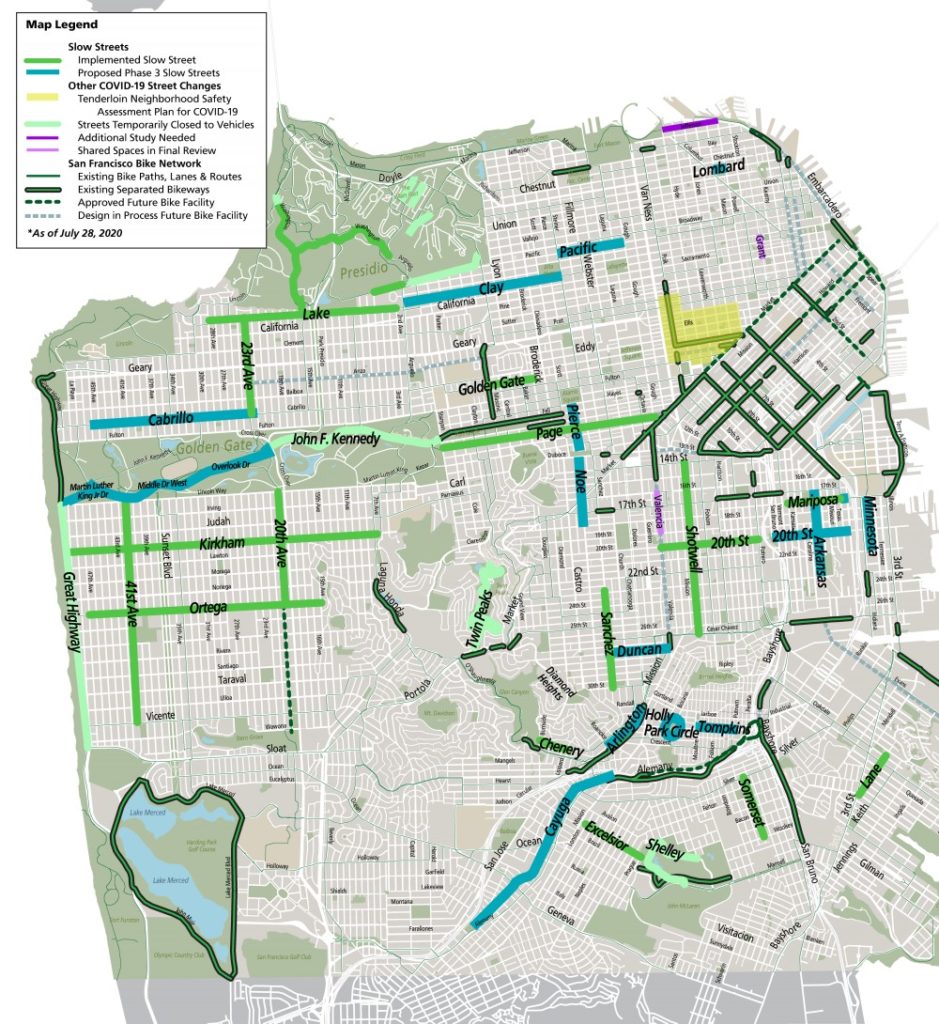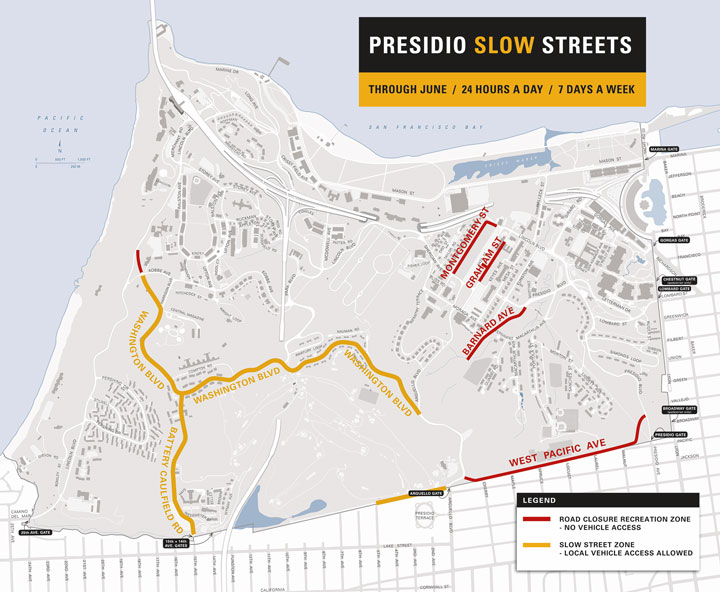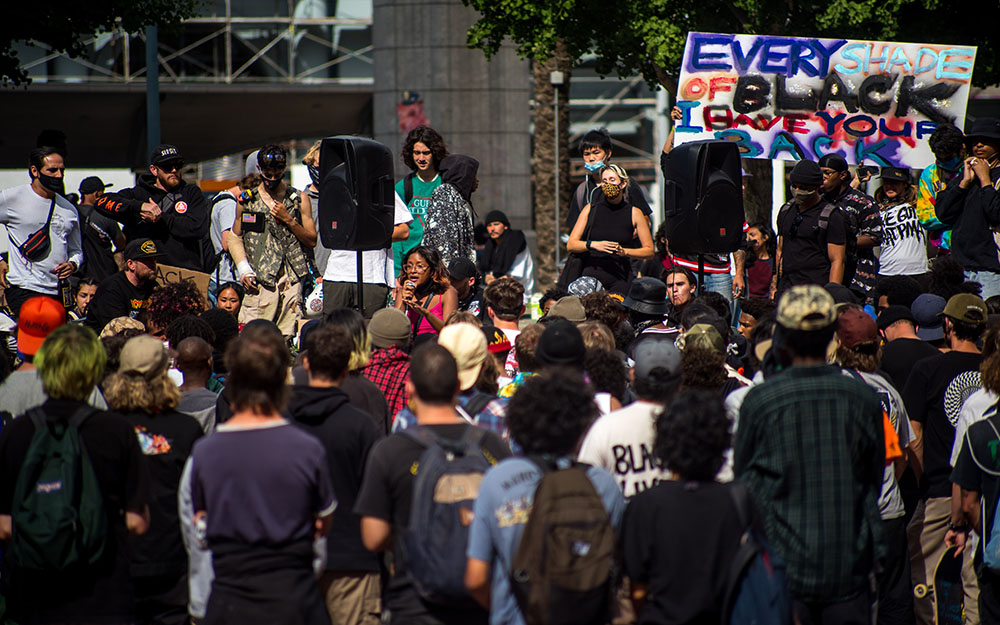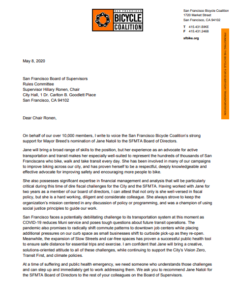Sheltering at home can make all of us squirrelly, children especially. As a parent or caretaker, you might be dealing with new stresses, from working at home to recent joblessness to the wild uncertainty facing all of us. Children are also dealing with stress, as they’re trying to adjust to remote learning, missing friends, not getting enough physical activity, and more. We all need to burn off these stresses. While it may not be an option for everyone right now, riding bikes in the fresh air as a family — allowed under current health department guidelines — is a great way to unwind.
This need is one of the reasons that City officials have been restricting or eliminating motor-vehicle access to more and more streets in San Francisco, making them more accessible for walking and biking. Car-free streets are welcoming places for city residents to get exercise and fresh air, while maintaining the physical distance that will help us all stay healthy. The routes described here are all great places for your family to ride. Many are in or near parks, so if your young ones need a rest, there’s open space for you to do so. And as the City continues to expand its Slow Streets program, we’ll update this blog with more family-friendly routes.
Of course, precautions still need to be taken. Here are a few things to keep in mind:
- Children will likely need to be reminded to maintain 6 feet away from people you don’t live with.
- Masks or face coverings are not required while biking, but adults and youth 13 and older should wear them when not riding; masks are optional but recommended for children aged 3-12 when not biking.
- These car-free spaces are becoming increasingly popular. In order to keep children safe and out of others’ 6-foot bubbles, guardians should watch children carefully and encourage them to ride in straight lines, remaining observant of those around them.
- Frequently using hand sanitizer and wiping down handlebars with disinfectant wipes will help reduce the risk of infection.
New to taking your children out on bikes? Check out some helpful tips below, and see other great resources from the SF Safe Routes to School partnership.
Great routes for biking with your whole family
1. JFK Drive, Golden Gate Park, between Kezar and Transverse
For years, weekend closures of JFK Drive during warmer months have been extremely popular with walkers, runners, bikers, and families seeking a beautiful, car-free space to spend time outdoors. After a few weeks of Shelter-in-Place, the Mayor’s Office announced that this stretch of road would be closed completely for the duration of the order. JFK Drive is relatively flat for most of its length, but it does have a couple of minor slopes. These can be great places for teaching young ones to ride, because on pedal-less push bikes they can pick up enough momentum to glide for long distances, building their balance and confidence.
Nearby bike shops: Avenue Cyclery (415-387-3155); American Cyclery (415-664-4545) (Call to confirm hours and availability)
Getting there: As always, we recommend riding there. If you must drive, street parking is available in the Inner Richmond, near the 8th Avenue entrance. At least through May, street-sweeping and 3-hour parking restrictions are unenforced.
2. The Great Highway, between Lincoln and Sloat
This stretch of divided road along Ocean Beach is occasionally closed due to drifting sand, which is ostensibly the reason it was closed this time. However, Supervisor Gordon Mar has requested that it remain closed for the duration of Shelter-in-Place. It is completely flat and straight, making it an easy place for inexperienced pedalers to practice. Its proximity to Ocean Beach creates a great opportunity for a full-day family outing, since it’s easy to spend time in the sand while staying more than six feet from others.
Nearby bike shops: Swell Bicycles (415-731-3838) (Call to confirm hours and availability)
Getting there: As always, we recommend riding there. If you must drive, please note that all Ocean Beach parking lots are closed; street parking is available in the Outer Sunset. At least through May, street-sweeping and 3-hour parking restrictions are unenforced.
3. Twin Peaks Blvd, east half of the figure-8
This section of road closed a few years back as a pilot program and is now permanently car-free! It has wonderful views of the Bay, and kids love to clamber up the eponymous peaks. That said, it can be windy up there, so come prepared with layers; consider bringing wind-breakers. Getting there can also be a challenge, since it is all the way at the top of the hill.
Nearby bike shops: There aren’t great options nearby, so be sure to do an ABC Quick Check on all bikes before you head there!
Getting there: Parking options are nearly nonexistent, so it’s best for those who live nearby or those who can handle riding the hill!
4. Shelley Drive, McLaren Park
At the same time that the Mayor’s Office announced the JFK Drive closure in Golden Gate Park, they announced the closure to cars of this semi-loop in the city’s second-largest park. A great resource for those living in or near the southeast of the city, Shelley Drive has some slopes that are fun for kids to roll down without picking up too much steam. Please note that, although the Mayor’s Office announced that the entire Shelley Drive loop would be closed to vehicles, currently only the western portion between Mansell Street and Cambridge Street are closed (see map).
Nearby bike shops: The southeast of the city continues to lack bike shops — check your bike before you head out!
Getting there: As always, we recommend riding there. If you must drive, street parking is available in the neighborhoods north of the park; enter at Cambridge Street. At least through May, street-sweeping and 3-hour parking restrictions are unenforced.
5. Heron’s Head Park
Jutting out from India Basin into the San Francisco Bay, Heron’s Head Park has beautiful views of the bay. The half-mile trail that runs out the peninsula of this wetlands park is flat gravel; it’s a mixed-use path, so respect people walking and running. Encourage your young ones to count the number of different birds they see out here!
Nearby bike shops: The southeast of the city continues to lack bike shops — check your bike before you head out!
Getting there: As always, we recommend riding there, especially because Evans Avenue and Cargo Way both have easily accessible bike lanes. If you must drive, street parking is available along Jennings Street. At least through May, street-sweeping and 3-hour parking restrictions are unenforced.
6. SF Slow Streets

Since late April, San Francisco has been rolling out several miles of “Slow Streets,” which are streets that are closed to through vehicle traffic in order to make more space for people to be out walking, running, biking, and rolling while maintaining 6 feet of physical distance. Many of these streets will feel very comfortable for families biking together, but there are important considerations as you plan your outing.
For one thing, streets are not entirely closed to vehicles, unlike most of the others on this list. People who live on the streets, mail carriers, Amazon delivery vans, and others still will occasionally drive through, hopefully very slowly and carefully. Still, be sure you keep a close eye on your children, and be sure they understand what to do if you tell them to stop, slow, or stay to one side or another.
Additionally, streets crossing Slow Streets are not closed, so be sure to obey traffic signals and stop signs at intersections. This can be a great opportunity to start teaching your children about the importance of safe, legal, predictable riding! On most Slow Streets, intersections are well marked with barricades, but only at every other intersection; thus, unsuspecting people behind the wheel could turn onto a Slow Street at an unmarked intersection. Please use extra caution at unmarked intersections.
Here are some specific notes on various Slow Streets that are currently implemented:
- Lake Street, 2nd Avenue to 28th Avenue — This street is particularly well-marked and relatively flat and wide. Use caution near busy intersections, such as Park Presidio. But most of the length of Lake Street is family-friendly.
- Kirkham Street, 7th Avenue to the Great Highway — Similarly well marked, Kirkham is also a nice wide street. It has varied topography — stretches of it are flat, but a few blocks have some serious slopes. Be careful with younger riders on slopes that approach intersections, where cross traffic still flows.
- Sanchez Street, 23rd Street to 30th Street — Like Lake Street, Sanchez is wide and mostly flat, with well-marked intersections. Great for families!
- Page Street, Gough Street to Stanyan Street — Page Street is less well-marked than I would like it to be, and some blocks are quite steep. The best-marked, flattest blocks are in the Upper Haight, closer to Golden Gate Park. We recommend riding the route without children to determine suitability.
- Shotwell Street, 14th Street to Cesar Chavez — This street is relatively flat and adequately marked, for the most part. However, the street is also much more narrow than the other Slow Streets, with many cars parked along the curbs. Be sure to remind children to ride far out from parked cars, in order to avoid doors unexpectedly opening or cars pulling out of driveways.
- 41st Avenue, Lincoln Way to Vicente Street — Like Lake Street, 41st Avenue is wide and flat. It’s great for families on bikes, but do watch out for intersections!
Other streets have been implemented recently, such as 20th Street in the Mission, 23rd Avenue in the Richmond, and Somerset Street in Portola. We’ll do our best to update recommendations soon!
7. The Presidio, various slow and closed streets

The Presidio, after experimenting in May with a one-day-a-week closure, is providing a mix of full-time closed and slow streets in June (and perhaps longer). They’ve chosen streets for the project based on their accessibility for young people and families, with relatively flat grades and easy access to grassy open space and bathrooms near Graham and Montgomery Streets. The Presidio is well known for its varied natural beauty, and parts of Washington Blvd have especially beautiful views. Because slow streets aren’t entirely closed, we recommend bringing less experienced riders to closed streets, marked in red in the map above.
Nearby bike shops: Roaring Mouse Cycles (415-753-6272) (Call to confirm hours and availability)
Getting there: As always, we recommend riding there. If you must drive, street parking is available in the neighborhoods south and west of the park, especially near the Arguello and Lombard gates. Trying to park inside the Presidio isn’t recommended.
Other tips for family rides
Set yourself up for a great, fun day by being well prepared! Before you head out, check your own and your children’s bikes for any problems, and make sure that everyone’s helmets are properly fitted. And bring everything you’ll need!
- Bring snacks and plenty of water — your children will get hungry and thirsty before you do!
- Remember to take regular breaks, so nobody gets meltdown-tired.
- Consider bringing lunch and a blanket — a picnic is a great way to take a break.
- Bring a basic first-aid kit, so you’re prepared for any potential spills
- Consider riding the route before you bring your children, to make sure you feel confident they’ll be able to handle it.
- Remember masks for you and your child, as well as hand sanitizer and wipes for your handlebars — and use them liberally!
- All of these routes are mixed-use, and pedestrians always have the right of way. Remind your children frequently to respect people’s 6-foot bubbles, and encourage them to ride predictably (i.e. in a straight line). You can even make a game of “who can ride the straightest line”.
- HAVE FUN!
Want to find out more about riding bikes with your children? Attend our upcoming webinar, Biking with Children, on May 28!





